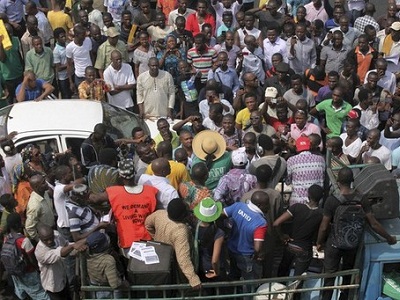The official launch of the World Bank’s e-Sourcebook, “ICT in Agriculture: Connecting Smallholders to Knowledge, Networks and Institutions” took place at the premises of the Bank on Wednesday January 18 2012, with a number of activities.
Among these activities was a panel discussion on the key modules in the book moderated by Mark E. Cackler, the Manger of the Agriculture and Rural Development Department of the World Bank. Members of the panel included Willem Janssen, the Lead Agriculture Specialist in the Latin America and Caribbean Region; Laurent Besancon, Senior Regulatory Specialist in charge of ICT portfolio for the Sub-Saharan Africa region; Tuukka Castren, Senior Forest Specialist at the Agriculture and Rural Development (ARD) department of the Bank; Aparajita Goyal, an Economist at the Agriculture and Rural Development (ARD); and Shaun Ferris, Senior Technical Advisor for Agriculture and Environment at Catholic Relief Services (CRS).
Introducing the book, Tim Kelly, the Lead ICT Policy Specialist in the ICT unit of the Bank stated clearly that the e-Sourcebook is neither academic paper, a report nor cookbook for use. However, it provides development practitioners and governments with examples of where ICT in agriculture has been used, challenges and lessons learned using ICT, and guidelines on project development. It also attempts to address how ICT can be mainstreamed into agricultural interventions, research and entrepreneurship.
A Science Advisor at the Agriculture and Rural Development Department at the Bank, Eija Pehu shared some of the key findings and themes from the book. This includes the need to focus on the demand for services but not on the technology, understanding the users and their demands, providing the enabling environment, exploring sustainable business models, being aware of differential impacts of ICT projects such as gender, age and socio-economic status of the users, and recognizing that smart and higher capacity tools are becoming more affordable.
The highlight of the panel presentation featured an interesting mobile application demonstrated by Shaun Ferris from CRS that is being used for data collection, monitoring and assessment by agricultural field workers to share information and report to the main office. iFormBuilder is currently being used by Catholic Relief Services in a number of remote communities to facilitate data sharing and reporting.
Questions and Answer Session
Two main themes that emerged during the Q&A session were the need to i) identify and show evidence for the impacts of these ICT applications in agriculture on the socio-economic status and livelihood conditions of the farmers; and ii) look more into innovative ways of using ICTs to increase productivity of farmers in addition to the current emphasis on market information systems. It was pointed out that while the e-Sourcebook has good examples of each of the two above areas, more need to be done.
Also a number of academic and research institutes are currently working with some of the ICT projects to understand the relationship between ICTs use by local farmers and improvement in their socio-economic conditions. The conclusion, however, was that it is going to be a difficult task identifying this relationship looking at the number of ways by which the farmers use a given ICT. For example a mobile phone may be used to check weather updates, as an alarm clock, a clock to inform farmers about when to leave for home, make phone calls, check emails, etc.
The Structure of the Book
Organized into 4 main themes and 15 modules:
Section One (Introduction) covers topics like ICT in Agricultural Development (Module 1); Making ICT Infrastructure, Appliances and Services More Accessible and Affordable in Rural Areas (Module 2); Anywhere, Anytime – Mobile Devices and Their Impact on Agriculture and Rural Development (Module 3); and Extending the Benefits: Gender Equitable-ICT Enabled Agricultural Development (Module 4).
Section Two (Enhancing Productivity on the Farm) includes Increasing Crop, Livestock and Fishery Productivity Through ICT (Module 5); ICTs As Enablers of Agricultural Innovation Systems (Module 6); Broadening Smallholders’ Access to Financial Services Through ICTs (Module 7); and Farmer Organizations Work Better with ICT (Module 8).
The Third Section (Assessing Markets and Value Chains) addresses issues of Strengthening Agricultural Marketing with ICT (Module 9); ICT Applications for Smallholder Inclusion in Agribusiness Supply Chains (Module 10); ICT Applications for Agricultural Risk Management (Module 11); and Global Markets, Global Challenges: Improving Food Safety and Traceability While Empowering Smallholders Through ICT (Module 12).
The Fourth and Final Section (Improving Public Service Provision) covers Strengthening Rural Governance, Institutions, and Citizen Participation Through ICT (Module 13); ICT for Land Administration and Management (Module 14) and Using ICT to Improve Forest Governance (Module 15).
What Next at the Bank?
The Bank will be looking into the operational challenges of some of these ICTs applications identified in the book, develop regional task force to follow-up with the progress, and also continue to organize online fora on selected topics in the book, the first of which took place in December 2011 on “Strengthening Agricultural Marketing with ICT.“
The e-Sourcebook is freely available here.















































